La Trobe University: Scientific vs. Human Relations in Management
VerifiedAdded on 2023/06/11
|6
|1951
|340
Essay
AI Summary
This essay compares and contrasts the contributions of scientific management, pioneered by Frederick Winslow Taylor, and the human relations movement, influenced by Elton Mayo, to modern management theory and practice. It explores Taylor's focus on industrial efficiency, time and motion studies, and monetary incentives, contrasting it with Mayo's emphasis on social needs, job satisfaction, and the impact of informal groups on productivity. The essay analyzes how scientific management views employees as economic beings motivated primarily by financial rewards, while the human relations movement sees them as social beings driven by relationships and emotional satisfaction. Ultimately, the essay concludes that both theories contribute valuable insights and that a modern manager should blend these approaches to achieve organizational excellence. Desklib provides access to this and other solved assignments for students seeking comprehensive study resources.
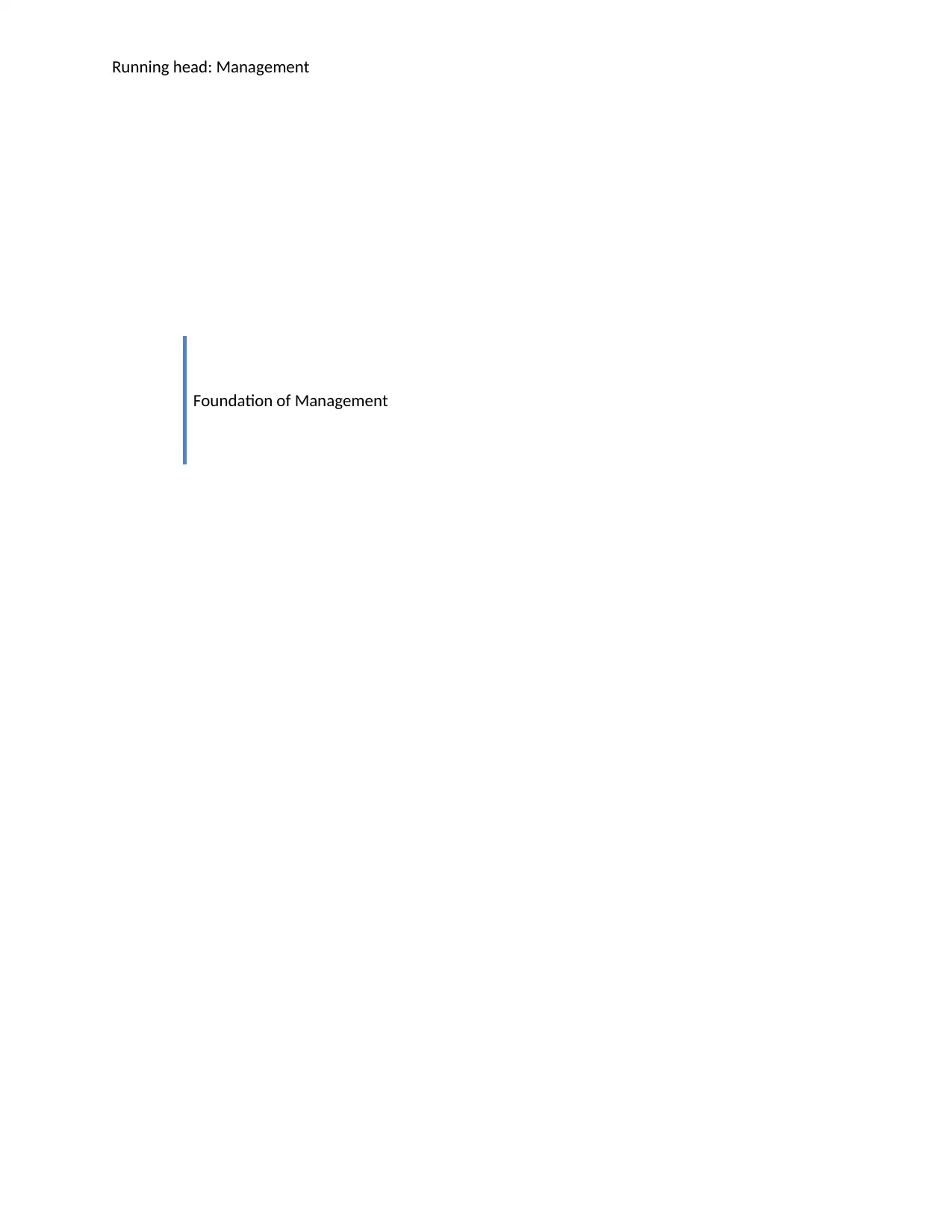
Running head: Management
Foundation of Management
Foundation of Management
Paraphrase This Document
Need a fresh take? Get an instant paraphrase of this document with our AI Paraphraser
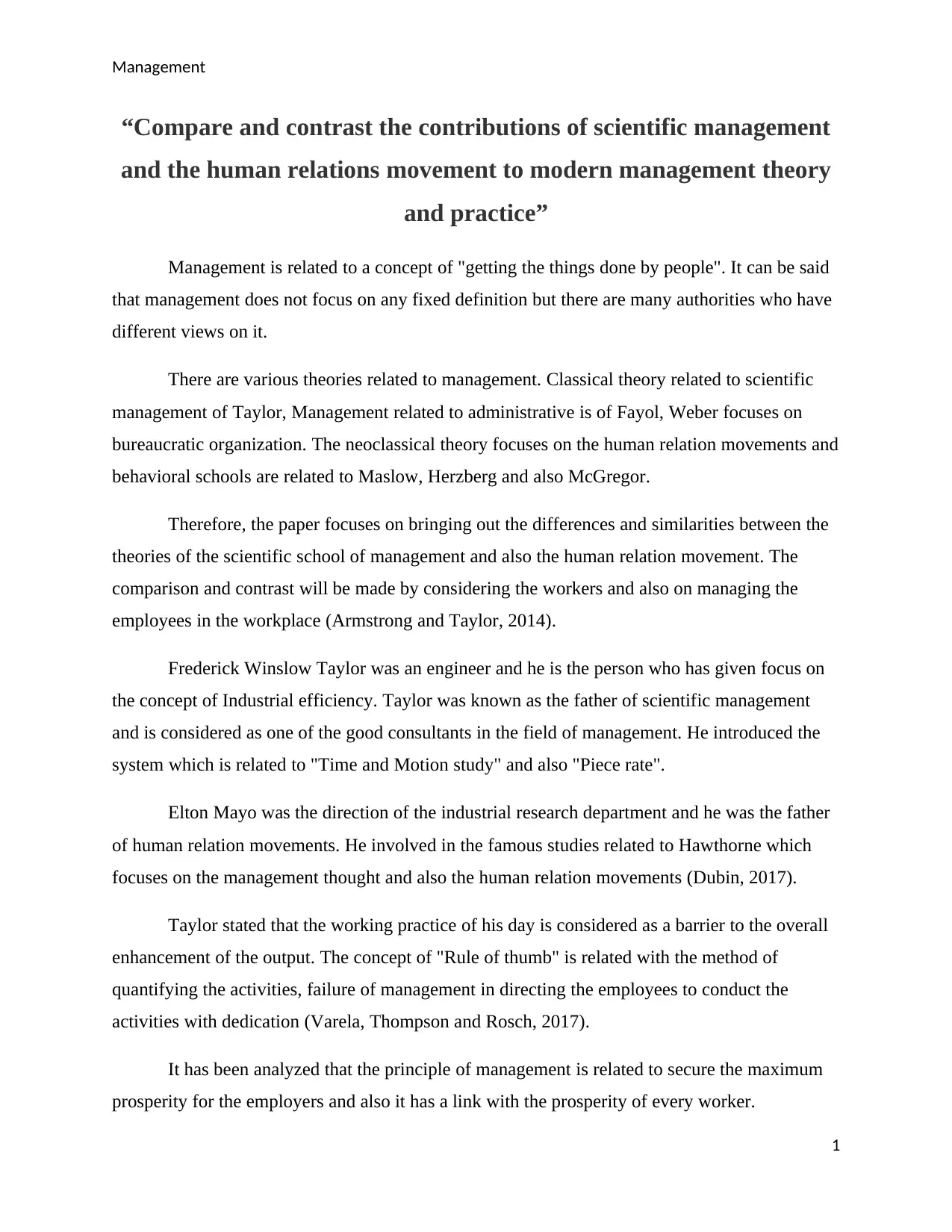
Management
“Compare and contrast the contributions of scientific management
and the human relations movement to modern management theory
and practice”
Management is related to a concept of "getting the things done by people". It can be said
that management does not focus on any fixed definition but there are many authorities who have
different views on it.
There are various theories related to management. Classical theory related to scientific
management of Taylor, Management related to administrative is of Fayol, Weber focuses on
bureaucratic organization. The neoclassical theory focuses on the human relation movements and
behavioral schools are related to Maslow, Herzberg and also McGregor.
Therefore, the paper focuses on bringing out the differences and similarities between the
theories of the scientific school of management and also the human relation movement. The
comparison and contrast will be made by considering the workers and also on managing the
employees in the workplace (Armstrong and Taylor, 2014).
Frederick Winslow Taylor was an engineer and he is the person who has given focus on
the concept of Industrial efficiency. Taylor was known as the father of scientific management
and is considered as one of the good consultants in the field of management. He introduced the
system which is related to "Time and Motion study" and also "Piece rate".
Elton Mayo was the direction of the industrial research department and he was the father
of human relation movements. He involved in the famous studies related to Hawthorne which
focuses on the management thought and also the human relation movements (Dubin, 2017).
Taylor stated that the working practice of his day is considered as a barrier to the overall
enhancement of the output. The concept of "Rule of thumb" is related with the method of
quantifying the activities, failure of management in directing the employees to conduct the
activities with dedication (Varela, Thompson and Rosch, 2017).
It has been analyzed that the principle of management is related to secure the maximum
prosperity for the employers and also it has a link with the prosperity of every worker.
1
“Compare and contrast the contributions of scientific management
and the human relations movement to modern management theory
and practice”
Management is related to a concept of "getting the things done by people". It can be said
that management does not focus on any fixed definition but there are many authorities who have
different views on it.
There are various theories related to management. Classical theory related to scientific
management of Taylor, Management related to administrative is of Fayol, Weber focuses on
bureaucratic organization. The neoclassical theory focuses on the human relation movements and
behavioral schools are related to Maslow, Herzberg and also McGregor.
Therefore, the paper focuses on bringing out the differences and similarities between the
theories of the scientific school of management and also the human relation movement. The
comparison and contrast will be made by considering the workers and also on managing the
employees in the workplace (Armstrong and Taylor, 2014).
Frederick Winslow Taylor was an engineer and he is the person who has given focus on
the concept of Industrial efficiency. Taylor was known as the father of scientific management
and is considered as one of the good consultants in the field of management. He introduced the
system which is related to "Time and Motion study" and also "Piece rate".
Elton Mayo was the direction of the industrial research department and he was the father
of human relation movements. He involved in the famous studies related to Hawthorne which
focuses on the management thought and also the human relation movements (Dubin, 2017).
Taylor stated that the working practice of his day is considered as a barrier to the overall
enhancement of the output. The concept of "Rule of thumb" is related with the method of
quantifying the activities, failure of management in directing the employees to conduct the
activities with dedication (Varela, Thompson and Rosch, 2017).
It has been analyzed that the principle of management is related to secure the maximum
prosperity for the employers and also it has a link with the prosperity of every worker.
1
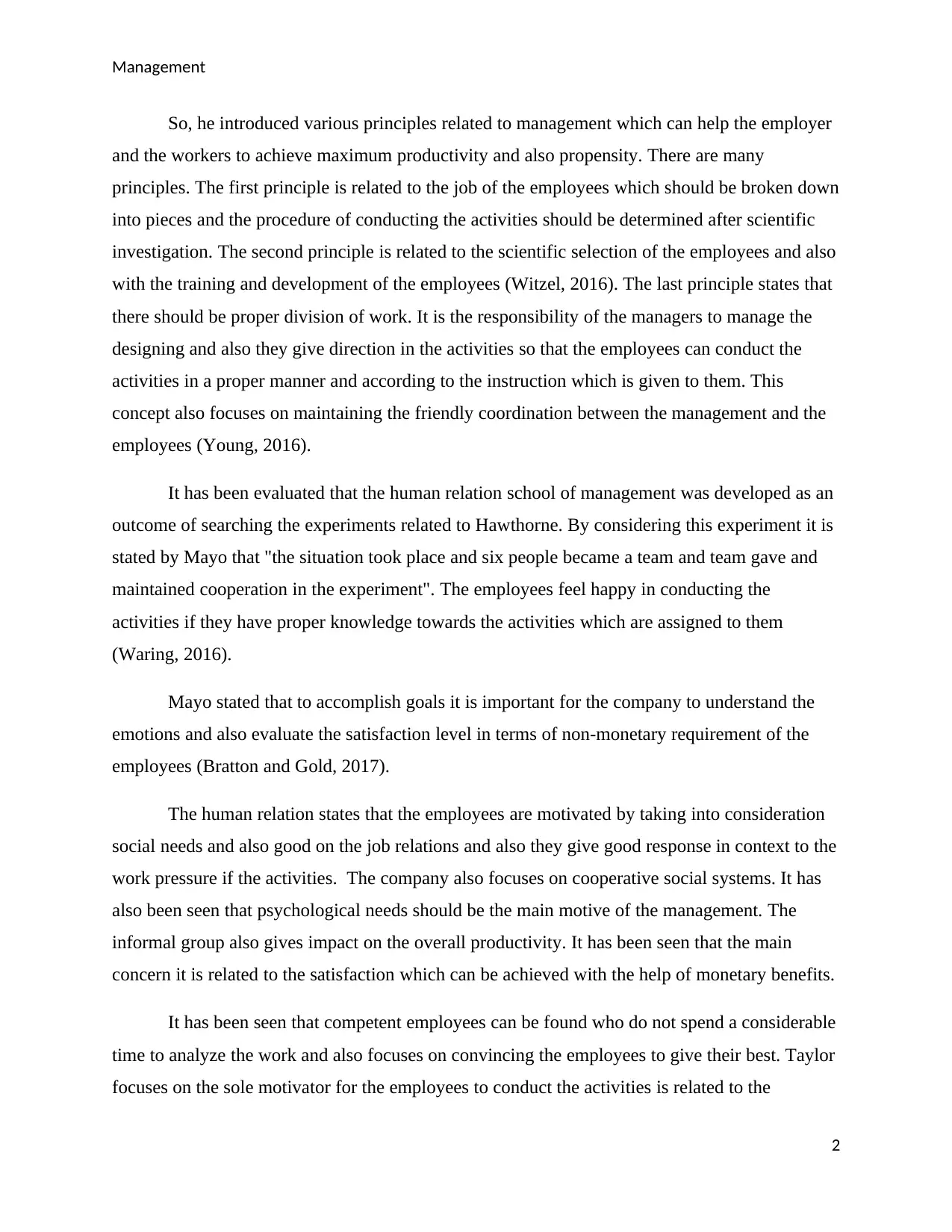
Management
So, he introduced various principles related to management which can help the employer
and the workers to achieve maximum productivity and also propensity. There are many
principles. The first principle is related to the job of the employees which should be broken down
into pieces and the procedure of conducting the activities should be determined after scientific
investigation. The second principle is related to the scientific selection of the employees and also
with the training and development of the employees (Witzel, 2016). The last principle states that
there should be proper division of work. It is the responsibility of the managers to manage the
designing and also they give direction in the activities so that the employees can conduct the
activities in a proper manner and according to the instruction which is given to them. This
concept also focuses on maintaining the friendly coordination between the management and the
employees (Young, 2016).
It has been evaluated that the human relation school of management was developed as an
outcome of searching the experiments related to Hawthorne. By considering this experiment it is
stated by Mayo that "the situation took place and six people became a team and team gave and
maintained cooperation in the experiment". The employees feel happy in conducting the
activities if they have proper knowledge towards the activities which are assigned to them
(Waring, 2016).
Mayo stated that to accomplish goals it is important for the company to understand the
emotions and also evaluate the satisfaction level in terms of non-monetary requirement of the
employees (Bratton and Gold, 2017).
The human relation states that the employees are motivated by taking into consideration
social needs and also good on the job relations and also they give good response in context to the
work pressure if the activities. The company also focuses on cooperative social systems. It has
also been seen that psychological needs should be the main motive of the management. The
informal group also gives impact on the overall productivity. It has been seen that the main
concern it is related to the satisfaction which can be achieved with the help of monetary benefits.
It has been seen that competent employees can be found who do not spend a considerable
time to analyze the work and also focuses on convincing the employees to give their best. Taylor
focuses on the sole motivator for the employees to conduct the activities is related to the
2
So, he introduced various principles related to management which can help the employer
and the workers to achieve maximum productivity and also propensity. There are many
principles. The first principle is related to the job of the employees which should be broken down
into pieces and the procedure of conducting the activities should be determined after scientific
investigation. The second principle is related to the scientific selection of the employees and also
with the training and development of the employees (Witzel, 2016). The last principle states that
there should be proper division of work. It is the responsibility of the managers to manage the
designing and also they give direction in the activities so that the employees can conduct the
activities in a proper manner and according to the instruction which is given to them. This
concept also focuses on maintaining the friendly coordination between the management and the
employees (Young, 2016).
It has been evaluated that the human relation school of management was developed as an
outcome of searching the experiments related to Hawthorne. By considering this experiment it is
stated by Mayo that "the situation took place and six people became a team and team gave and
maintained cooperation in the experiment". The employees feel happy in conducting the
activities if they have proper knowledge towards the activities which are assigned to them
(Waring, 2016).
Mayo stated that to accomplish goals it is important for the company to understand the
emotions and also evaluate the satisfaction level in terms of non-monetary requirement of the
employees (Bratton and Gold, 2017).
The human relation states that the employees are motivated by taking into consideration
social needs and also good on the job relations and also they give good response in context to the
work pressure if the activities. The company also focuses on cooperative social systems. It has
also been seen that psychological needs should be the main motive of the management. The
informal group also gives impact on the overall productivity. It has been seen that the main
concern it is related to the satisfaction which can be achieved with the help of monetary benefits.
It has been seen that competent employees can be found who do not spend a considerable
time to analyze the work and also focuses on convincing the employees to give their best. Taylor
focuses on the sole motivator for the employees to conduct the activities is related to the
2
⊘ This is a preview!⊘
Do you want full access?
Subscribe today to unlock all pages.

Trusted by 1+ million students worldwide
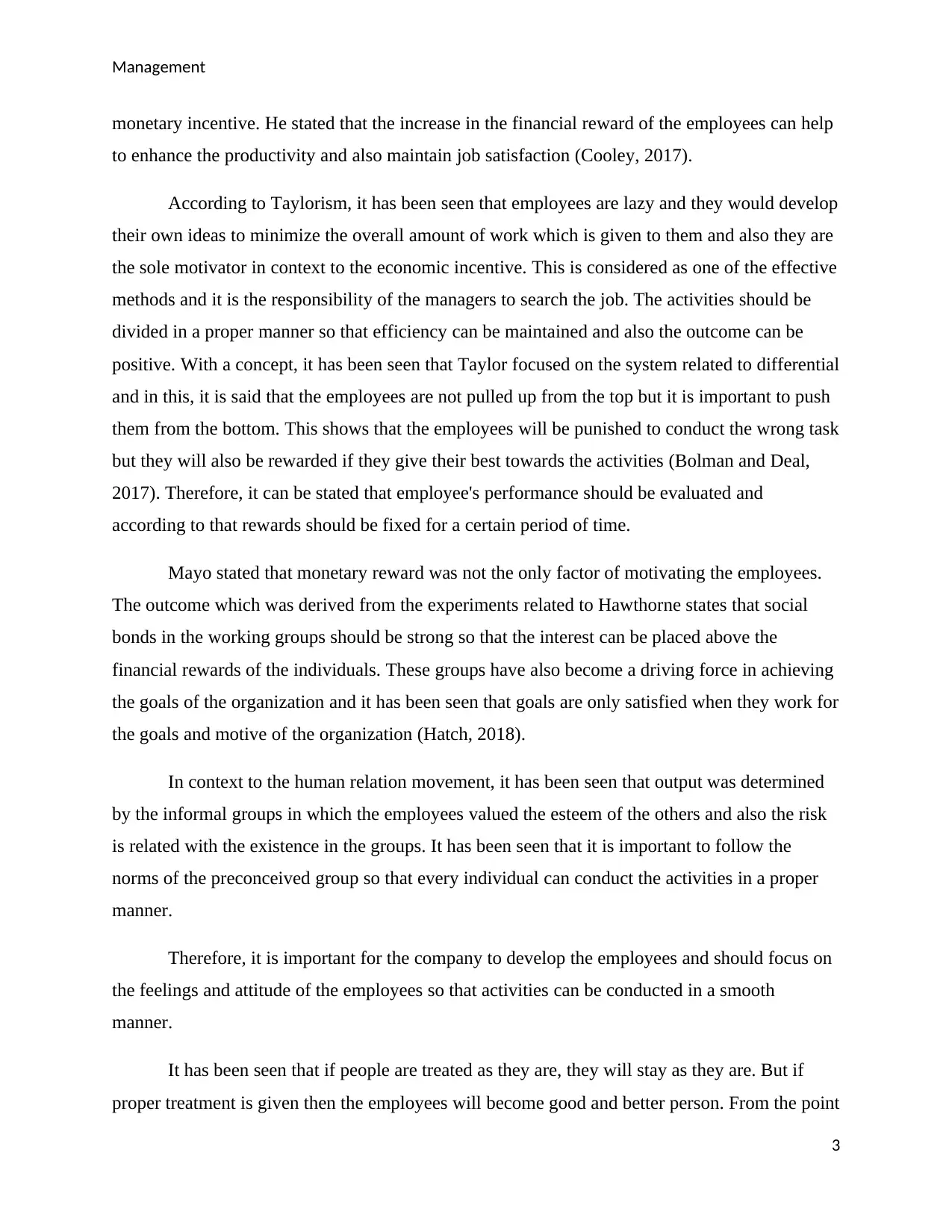
Management
monetary incentive. He stated that the increase in the financial reward of the employees can help
to enhance the productivity and also maintain job satisfaction (Cooley, 2017).
According to Taylorism, it has been seen that employees are lazy and they would develop
their own ideas to minimize the overall amount of work which is given to them and also they are
the sole motivator in context to the economic incentive. This is considered as one of the effective
methods and it is the responsibility of the managers to search the job. The activities should be
divided in a proper manner so that efficiency can be maintained and also the outcome can be
positive. With a concept, it has been seen that Taylor focused on the system related to differential
and in this, it is said that the employees are not pulled up from the top but it is important to push
them from the bottom. This shows that the employees will be punished to conduct the wrong task
but they will also be rewarded if they give their best towards the activities (Bolman and Deal,
2017). Therefore, it can be stated that employee's performance should be evaluated and
according to that rewards should be fixed for a certain period of time.
Mayo stated that monetary reward was not the only factor of motivating the employees.
The outcome which was derived from the experiments related to Hawthorne states that social
bonds in the working groups should be strong so that the interest can be placed above the
financial rewards of the individuals. These groups have also become a driving force in achieving
the goals of the organization and it has been seen that goals are only satisfied when they work for
the goals and motive of the organization (Hatch, 2018).
In context to the human relation movement, it has been seen that output was determined
by the informal groups in which the employees valued the esteem of the others and also the risk
is related with the existence in the groups. It has been seen that it is important to follow the
norms of the preconceived group so that every individual can conduct the activities in a proper
manner.
Therefore, it is important for the company to develop the employees and should focus on
the feelings and attitude of the employees so that activities can be conducted in a smooth
manner.
It has been seen that if people are treated as they are, they will stay as they are. But if
proper treatment is given then the employees will become good and better person. From the point
3
monetary incentive. He stated that the increase in the financial reward of the employees can help
to enhance the productivity and also maintain job satisfaction (Cooley, 2017).
According to Taylorism, it has been seen that employees are lazy and they would develop
their own ideas to minimize the overall amount of work which is given to them and also they are
the sole motivator in context to the economic incentive. This is considered as one of the effective
methods and it is the responsibility of the managers to search the job. The activities should be
divided in a proper manner so that efficiency can be maintained and also the outcome can be
positive. With a concept, it has been seen that Taylor focused on the system related to differential
and in this, it is said that the employees are not pulled up from the top but it is important to push
them from the bottom. This shows that the employees will be punished to conduct the wrong task
but they will also be rewarded if they give their best towards the activities (Bolman and Deal,
2017). Therefore, it can be stated that employee's performance should be evaluated and
according to that rewards should be fixed for a certain period of time.
Mayo stated that monetary reward was not the only factor of motivating the employees.
The outcome which was derived from the experiments related to Hawthorne states that social
bonds in the working groups should be strong so that the interest can be placed above the
financial rewards of the individuals. These groups have also become a driving force in achieving
the goals of the organization and it has been seen that goals are only satisfied when they work for
the goals and motive of the organization (Hatch, 2018).
In context to the human relation movement, it has been seen that output was determined
by the informal groups in which the employees valued the esteem of the others and also the risk
is related with the existence in the groups. It has been seen that it is important to follow the
norms of the preconceived group so that every individual can conduct the activities in a proper
manner.
Therefore, it is important for the company to develop the employees and should focus on
the feelings and attitude of the employees so that activities can be conducted in a smooth
manner.
It has been seen that if people are treated as they are, they will stay as they are. But if
proper treatment is given then the employees will become good and better person. From the point
3
Paraphrase This Document
Need a fresh take? Get an instant paraphrase of this document with our AI Paraphraser
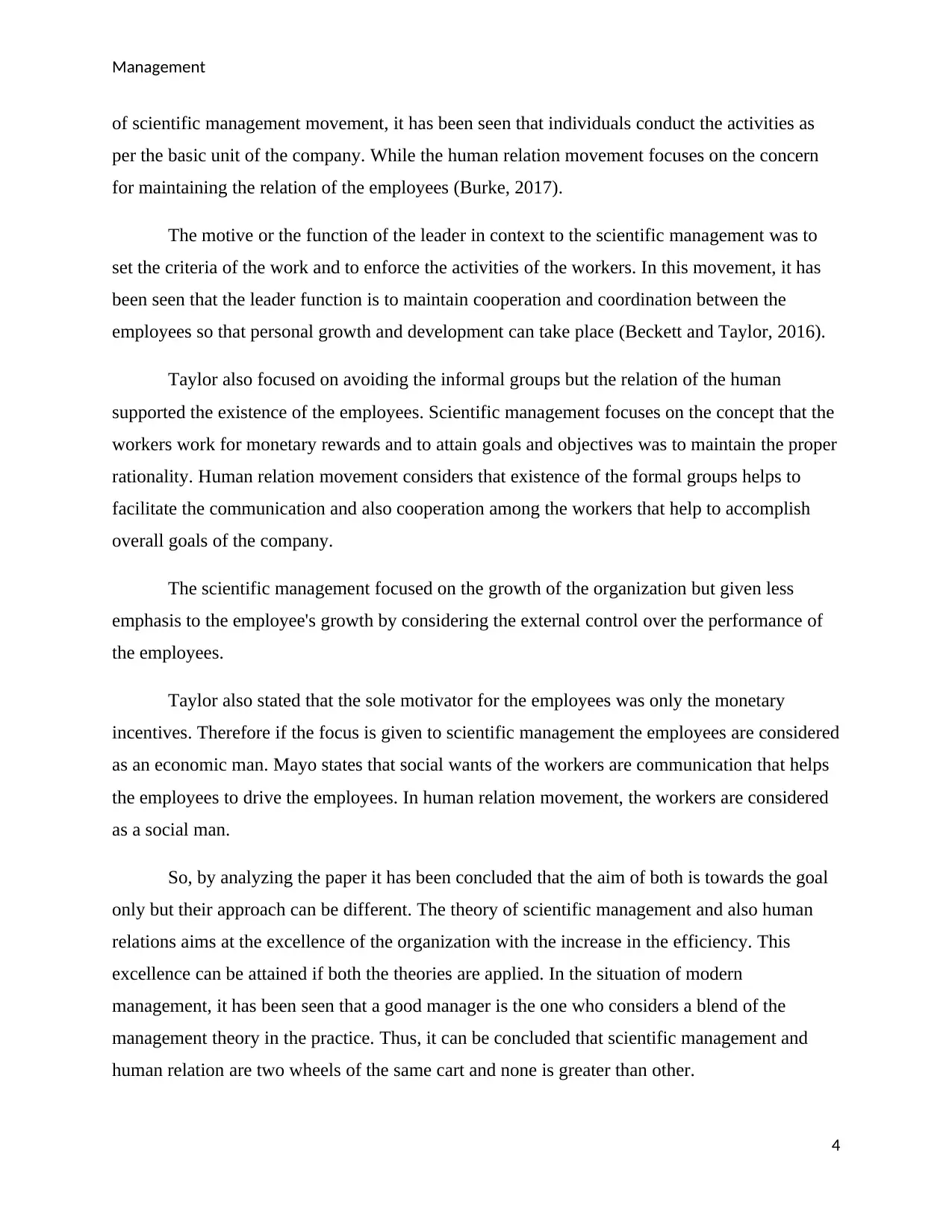
Management
of scientific management movement, it has been seen that individuals conduct the activities as
per the basic unit of the company. While the human relation movement focuses on the concern
for maintaining the relation of the employees (Burke, 2017).
The motive or the function of the leader in context to the scientific management was to
set the criteria of the work and to enforce the activities of the workers. In this movement, it has
been seen that the leader function is to maintain cooperation and coordination between the
employees so that personal growth and development can take place (Beckett and Taylor, 2016).
Taylor also focused on avoiding the informal groups but the relation of the human
supported the existence of the employees. Scientific management focuses on the concept that the
workers work for monetary rewards and to attain goals and objectives was to maintain the proper
rationality. Human relation movement considers that existence of the formal groups helps to
facilitate the communication and also cooperation among the workers that help to accomplish
overall goals of the company.
The scientific management focused on the growth of the organization but given less
emphasis to the employee's growth by considering the external control over the performance of
the employees.
Taylor also stated that the sole motivator for the employees was only the monetary
incentives. Therefore if the focus is given to scientific management the employees are considered
as an economic man. Mayo states that social wants of the workers are communication that helps
the employees to drive the employees. In human relation movement, the workers are considered
as a social man.
So, by analyzing the paper it has been concluded that the aim of both is towards the goal
only but their approach can be different. The theory of scientific management and also human
relations aims at the excellence of the organization with the increase in the efficiency. This
excellence can be attained if both the theories are applied. In the situation of modern
management, it has been seen that a good manager is the one who considers a blend of the
management theory in the practice. Thus, it can be concluded that scientific management and
human relation are two wheels of the same cart and none is greater than other.
4
of scientific management movement, it has been seen that individuals conduct the activities as
per the basic unit of the company. While the human relation movement focuses on the concern
for maintaining the relation of the employees (Burke, 2017).
The motive or the function of the leader in context to the scientific management was to
set the criteria of the work and to enforce the activities of the workers. In this movement, it has
been seen that the leader function is to maintain cooperation and coordination between the
employees so that personal growth and development can take place (Beckett and Taylor, 2016).
Taylor also focused on avoiding the informal groups but the relation of the human
supported the existence of the employees. Scientific management focuses on the concept that the
workers work for monetary rewards and to attain goals and objectives was to maintain the proper
rationality. Human relation movement considers that existence of the formal groups helps to
facilitate the communication and also cooperation among the workers that help to accomplish
overall goals of the company.
The scientific management focused on the growth of the organization but given less
emphasis to the employee's growth by considering the external control over the performance of
the employees.
Taylor also stated that the sole motivator for the employees was only the monetary
incentives. Therefore if the focus is given to scientific management the employees are considered
as an economic man. Mayo states that social wants of the workers are communication that helps
the employees to drive the employees. In human relation movement, the workers are considered
as a social man.
So, by analyzing the paper it has been concluded that the aim of both is towards the goal
only but their approach can be different. The theory of scientific management and also human
relations aims at the excellence of the organization with the increase in the efficiency. This
excellence can be attained if both the theories are applied. In the situation of modern
management, it has been seen that a good manager is the one who considers a blend of the
management theory in the practice. Thus, it can be concluded that scientific management and
human relation are two wheels of the same cart and none is greater than other.
4
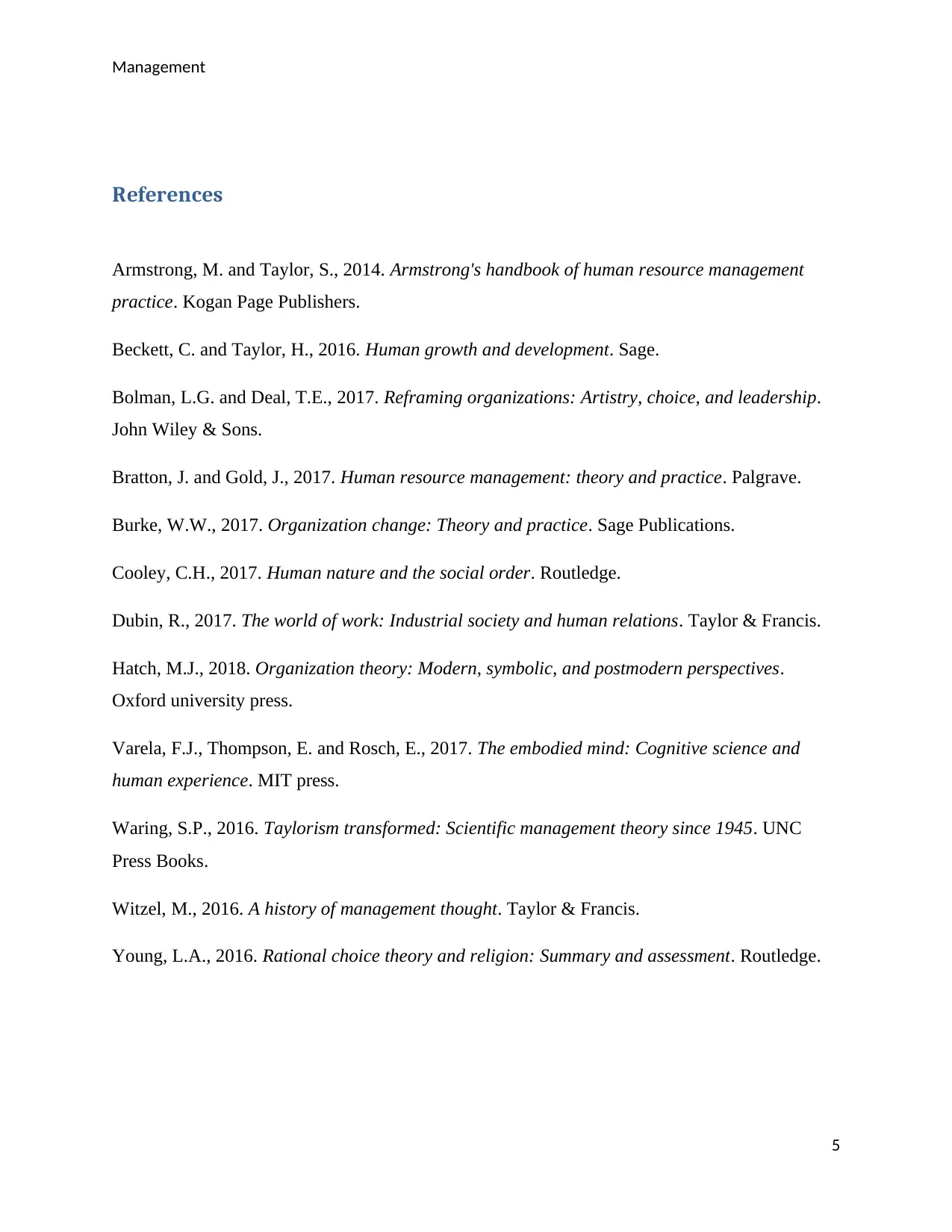
Management
References
Armstrong, M. and Taylor, S., 2014. Armstrong's handbook of human resource management
practice. Kogan Page Publishers.
Beckett, C. and Taylor, H., 2016. Human growth and development. Sage.
Bolman, L.G. and Deal, T.E., 2017. Reframing organizations: Artistry, choice, and leadership.
John Wiley & Sons.
Bratton, J. and Gold, J., 2017. Human resource management: theory and practice. Palgrave.
Burke, W.W., 2017. Organization change: Theory and practice. Sage Publications.
Cooley, C.H., 2017. Human nature and the social order. Routledge.
Dubin, R., 2017. The world of work: Industrial society and human relations. Taylor & Francis.
Hatch, M.J., 2018. Organization theory: Modern, symbolic, and postmodern perspectives.
Oxford university press.
Varela, F.J., Thompson, E. and Rosch, E., 2017. The embodied mind: Cognitive science and
human experience. MIT press.
Waring, S.P., 2016. Taylorism transformed: Scientific management theory since 1945. UNC
Press Books.
Witzel, M., 2016. A history of management thought. Taylor & Francis.
Young, L.A., 2016. Rational choice theory and religion: Summary and assessment. Routledge.
5
References
Armstrong, M. and Taylor, S., 2014. Armstrong's handbook of human resource management
practice. Kogan Page Publishers.
Beckett, C. and Taylor, H., 2016. Human growth and development. Sage.
Bolman, L.G. and Deal, T.E., 2017. Reframing organizations: Artistry, choice, and leadership.
John Wiley & Sons.
Bratton, J. and Gold, J., 2017. Human resource management: theory and practice. Palgrave.
Burke, W.W., 2017. Organization change: Theory and practice. Sage Publications.
Cooley, C.H., 2017. Human nature and the social order. Routledge.
Dubin, R., 2017. The world of work: Industrial society and human relations. Taylor & Francis.
Hatch, M.J., 2018. Organization theory: Modern, symbolic, and postmodern perspectives.
Oxford university press.
Varela, F.J., Thompson, E. and Rosch, E., 2017. The embodied mind: Cognitive science and
human experience. MIT press.
Waring, S.P., 2016. Taylorism transformed: Scientific management theory since 1945. UNC
Press Books.
Witzel, M., 2016. A history of management thought. Taylor & Francis.
Young, L.A., 2016. Rational choice theory and religion: Summary and assessment. Routledge.
5
⊘ This is a preview!⊘
Do you want full access?
Subscribe today to unlock all pages.

Trusted by 1+ million students worldwide
1 out of 6
Related Documents
Your All-in-One AI-Powered Toolkit for Academic Success.
+13062052269
info@desklib.com
Available 24*7 on WhatsApp / Email
![[object Object]](/_next/static/media/star-bottom.7253800d.svg)
Unlock your academic potential
Copyright © 2020–2025 A2Z Services. All Rights Reserved. Developed and managed by ZUCOL.





